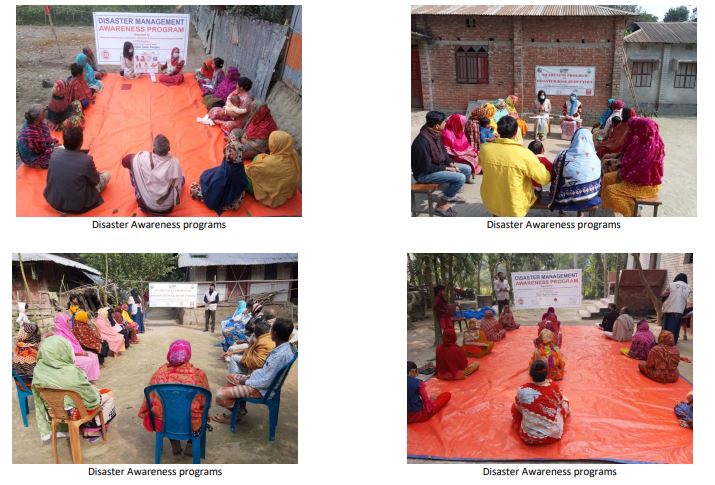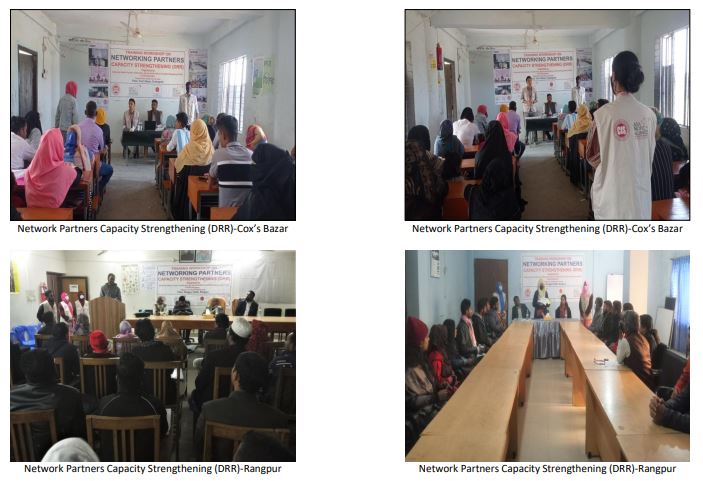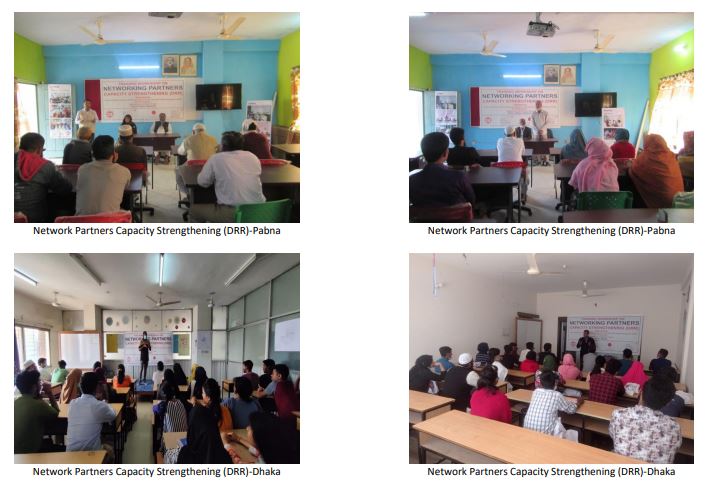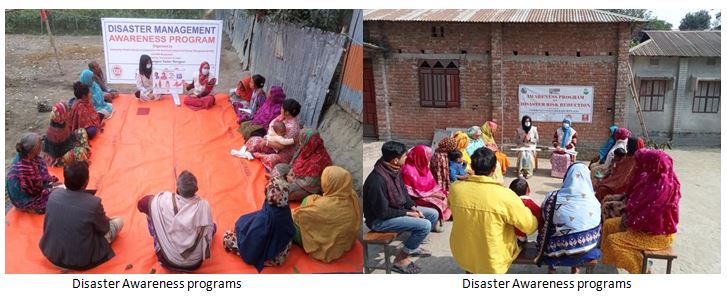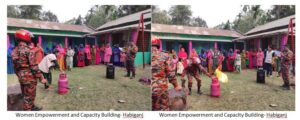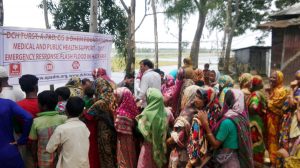Project Title: Strengthening Capacity for Sustainable Disaster Management Network by involving multi-sectoral platform Project Period: 17 January, 2023 – 16 January, 2024 (12 month)
- Project Activities and Accomplishments
Bangladesh is one of the most vulnerable countries to natural disasters and, due to climate change; we are facing natural disasters almost every year. Combined with the country’s geographical location, topography, and dense population, disaster events often result in high loss of life and economic loss, though Bangladesh has been successfully reducing the loss of human lives over the years. The frequency and intensity of natural disasters have been increased in recent years due t o climate change. The climatic events have serious consequences on broad agricultural sectors, food security, water, health and sanitation and leave serious impacts on life and livelihood of the communities. But so far we have limited disaster risk related data to understand the depth of household and population characteristics and loss sustained by the community at the household levels.
A-PAD Bangladesh started project from January 2023 and presently continue it 17 January 2023 to build up capacity on disaster management. It communicates with the different sectors like local community, community leaders, stakeholders, GOVT. officials continuing training on disaster management. To hold training program A-PAD Bangladesh staff organized small community meeting to sharing ideas on disaster and introduced them about A-PAD Bangladesh activity. A-PAD Bangladesh working 8 divisionsal areas.
There are 1 health workers in each divisions whose are doing home visit and aware the local community about basic disaster awareness. The health workers gave basic ideas about disaster management. A-PAD Bangladesh working at the rural areas. If there would be any directions or announcement from GOVT. or any disaster related news has been published the health workers delivered the message to the local community. Total 2,547 persons were benefited from A-PAD Bangladesh on January 2023.
A-PAD Bangladesh attended coordination meeting at the 8 divisions in Office of Deputy Commissioner. At that meeting different NGOs had joined and explained their activities. Besides this what will be the next activities of the GOVT. and NGOs were discussed at that meeting.
1. To manage the emergency disaster management coordination centers in disaster-prone areas (Outcome 1) The disaster management coordination center in disaster vulnerable areas established in this project (3 year project) functions as a disaster response base in each region, and contributes for preventing the spread of health damage to local residents and community-led disaster risk reduction measures. | ||
Activities | Outcome Indicators to Measure Results: | Project Status: Achievements vs Outcome: If the activity is behind the schedule, please write the reason. |
1-1 Operation of Emergency Disaster Management Coordination Centers Beneficiaries: 10 people x 25 days x 8 divisions x 12 months = 24,000 people 50 people x 8 campaign x 12 months = 4,800 people | 【Indicators of Outcome】 1-1: The disaster response management centers in 8 places (Dhaka, Chattagram, Rajshahi, Khulna, Barisal, Sylhet, Rangpur and Mymensingh division) will be utilized and the necessary equipment for emergency health care will be prepared. We will establish a new emergency disaster management coordination center in Mymensingh division. The center will function as a resource center for sharing information on disasters and will be used as a venue for strategic planning meetings, training and workshops. The staff members including doctors and nurses visit the villages and carry out awareness activities related to emergency health measures, public health and disaster prevention for local residents, and ensure that each local resident takes appropriate preventive measures. (Indicator: number of visitors, record of services provided) 1-2: The PCR test lab installed in the previous project will | Total 1,455 people visited to the Disaster Management Coordination Center to discuss about disaster preparedness and health related issues. Dhaka: 224 Persons Cox’s Bazar: 210 Persons Pabna: 180 Persons Bagerhat: 165 Persons Patuakhali: 200 Persons Habiganj: 221 Persons Rangpur: 195 Persons Netrokona: 60 Persons Total = 1,455 Persons |
1-2 Disaster Management Awareness program Beneficiaries:15 participants x 3 sessions x 8 divisions x 12 months = 4,320 people | A-PAD Bangladesh conducted Disaster Management Awareness programs at the 8 divisional areas where 382 persons have participated. Total 3 times training organized at each divisional areas. Dhaka:15 Participantsx 3 Sessons= 45+4=49 Participants Cox’s Bazar: 15 Participantsx 3 Sessons= 45+3=48 Participants Pabna: 15 Participantsx 3 Sessons= 45+6=51 Participants Bagerhat: 15 Participantsx 3 Sessons= 45+4=49 | |
| continue to operate. In the first year of the project, testing will be conducted only for COVID-19. From the second year onwards, it will be expanded to other infectious diseases (tuberculosis, measles, hepatitis) according to the needs of local residents. (Indicator: number of tests, report of test results) | Participants Patuakhali: 15 Participantsx 3 Sessons= 45+3=48 Participants Habiganj: 15 Participantsx 3 Sessons= 45 Participants Rangpur: 15 Participantsx 3 Sessons= 45+2=47 Participants Netrokona: 15 Participantsx 3 Sessons= 45 Participants |
1-3 Operation of PCR lab Beneficiaries: 15 people x 25 days x 12 months = 4500 people(Monthly Goal: 15 persons x 25 days = 375 persons) |
A-PAD Bangladesh established PCR Lab for COVID-19 test. In Bangladesh number of COVID-19 patients has average in number. In January 2023 total 230 COVID-19 test has been done | |
2 Strengthening the disaster response platform network (Outcome 2) A-PAD BGD, NPF for disaster reduction and disaster response through collaboration between multi-sectors, will be established and expanded, and the disaster prevention and disaster capacity of its member organizations will be strengthened. | ||
2-1 Network partner meeting Participants : 100 people x 5 villages x 8 divisions = 4000 people | 【Indicators of Outcome】 2-1 Strategies, mechanism and action plan meeting among networking partners and local communities will be held to support the building of disaster cooperation framework.
2-2 For the aim of awareness and increase the knowledge on disaster preparedness and management among the local community, we will organize different rally and meeting on the disaster preparedness and SDGs related national/international days like 05 November World Tsunami Awareness Day, 13 October Disaster Risk Reduction Day, 22 April Earth Day and 16 December Victory Day (National). |
|
2-2 Disaster Preparedness Campaigns
Participants:100 people x 2 times x 8 divisions = 1,600 people |
| |
2.3 Network Partners Capacity Strengthening (DRR) | A-PAD Bangladesh conducted 2 days training program at 7 divisional areas where total 480 participants has joined the training programs. | |
Participants:30 people x 2 org x 8 divisions x 2 times =960 people |
2-3 For the aim of strengthening of partner organizations, disaster risk reduction (DRR) training will be held. The training contents includes community-based disaster risk management, planning DRR strategies, and risk analysis that effectively identifies hazards, capacities and vulnerabilities. (Indicator: Partner organizations)
2-4 In this seminar, participants from various fields will be invited to exchange opinions and discuss ways to discover innovations related to DRR proposed by community residents and local companies and realize ideas and inventions. (Indicator: To create innovative solutions, we aim to create a successful model for disaster response by combining technology and knowledge that transcends fields and innovating)
2-5 The international symposium will be held in Dhaka to widely share the cooperation between multi-actors at the central and regional levels in Bangladesh and the progress of the emergency health response system among participants who are involved in disaster response from inside and outside Bangladesh. International experts will be dispatched from A-PAD member countries to introduce advanced cases of NPF in each country. | 21-22 January 2023, Rangpur, Total Participants 60 22-23 January 2023, Habiganj, Total Participants 60 23-24 January 2023, Cox’s Bazar, Total Participants 60 24-25 January 2023, patuakhali, Total Participants 60 25-26 January 2023, Pabna, Total Participants 60 28-29 January 2023, Bagerhat, Total Participants 60 30-31 January 2023, Dhaka, Total Participants 60
Rangpur is one of the disaster-prone areas because the rivers Teesta flows through Rangpur and the main disasters of that area are Flood and river erosion, the main focus of the training workshop was how to improve Disaster Risk Reduction and build up on capacity for an emergency. Disaster reduction and management require comprehensive knowledge about hazardous events, the likelihood of the occurrence and the possible impacts. To improve Disaster Risk Reduction and build up capacity for emergency response during and after a disaster CIS arranged a 2 days training program in Rangpur. In this training program 2 local Ngo Participated. A total of 60 participants joined that training workshop. The training was conducted for Two days focusing on different topics. The main focus of the training was Strengthening Disaster Risk Reduction. Delta Development Project and NGO Forum Joined this training program. On 2nd day it was shared that we need to prevent and need to the |
| (Indicator: The international symposium will be held for a total of three days, one day for field trips (field visits), one day for pre-meetings, and one day for international symposiums.) | identification of disaster risks. 1. Development of disaster forecasting management. 2. Establishment of shelters. 3. Disaster preparedness. 4. Use of modern technology. 5. Volunteering in rescue operations. 6. Organizing drills on earthquakes, and fire.
The focus of the workshop is on strengthening the capacity of organizations to respond to disasters and reduce the risk of their impacts. Community initiative society arranged Networking Partners Capacity Strengthening (DRR) Habiganj on 22-23 January 2023. The participants of the Network Partners Capacity Strengthening (DRR) Workshop typically include representatives from organizations that are working in the field of disaster risk reduction, including government agencies, non-government organizations, academic institutions and community-based organizations. Habiganj Student Coordination Forum and Tasnuva Samim Foundation joined this training program. Habiganj Student Coordination Forum is a local NGO that is socially active non-government organization in Habiganj, Bangladesh that is dedicated to providing aid and support in various forms, including disaster response. Cox’s Bazar is one of the districts of Bangladesh already |
|
| vulnerable to many gradual change phenomena of climate change as well as climate change-related extreme events. It is expected that climate change will bring changes in the characteristics of natural hazards which will result in changes in physical, social and production systems.CIS conducted a 2 days training program in Rangpur. In this training program 2 local Ngo Participated. A total of 60 participants joined that training workshop. The training was conducted for Two days focusing on different topics. The main focus of the training was Strengthening Disaster Risk Reduction. The main key topics covered in Network Partners Capacity Strengthening (DRR) Workshop: 1. Disaster risk assessment: Participants will learn how to identify and assess the risks and vulnerabilities associated with disasters, and how to develop strategies to mitigate those risks. 2. Early warning systems: Participants will learn about the importance of early warning systems in disaster risk reduction, and how to implement effective early warning systems at the community level. 3. Community-based disaster risk management: Participants will learn about the role of communities in disaster risk reduction, and how to engage communities in disaster risk management activities. |
|
| 4. Effective response planning: Participants will learn about the key elements of an effective disaster response plan, and how to develop and implement effective response plans that meet the needs of communities. Patuakhali district is one of the disaster-prone areas in Bangladesh. On 24 & 25 January-2023 Community Initiative Society (CIS) organized a training workshop on Network Partners Capacity Strengthening DRR Training. For geographic location and weather conditions, cyclones, tidal floods, erratic rainfall, cold wave, arsenic contamination, and tornado are common in this area. The main focus of the training workshop was on building up capacity for emergency response during and after a disaster. A total of 60 participant’s Private Sector, local NGO’s and Government Officials attended the training workshop. The training was conducted for two days focusing on different topics. Bangladesh Development Society (BDS) and Ramanabad joined the training program. To develop an understanding of how Concern reduces risk in coastal areas this training focused on early warning and preparedness plans. CIS Conducted 2 days training program in Pabna for strengthening Networking Partners’ capacity. Pratik women & child organization and Bashori Sromo & Mohila Unnayon Sanstha joined in this training workshop. A total |
|
| of 60 participants joined this training program. Capacity needs extend to all sectors and all levels and are closely linked with many other functions of government and policy directives. Stakeholders both within and outside of government must work together and must integrate DRR considerations into all the work they do, including work that involves assessing or developing the capacity required. Disaster resilience requires all-stakeholder awareness of risk and the vulnerability factors that exacerbate it. Individuals, organizations, and societies must be able to gather and share risk information among those that need it – whether to act or to react. Any development activity conducted in the absence of information on risk and vulnerability is likely to exacerbate community or country risk, but the ability to receive and act on such information is not intrinsic. And just as risk information is vital to pre-disaster development and preparedness activities, it is key to avoiding the roots of risk and vulnerability in the aftermath of disasters during recovery and reconstruction. Bagerhat district is one of the disaster-prone areas in Bangladesh. For geographic location and weather conditions, cyclones, tidal floods, erratic rainfall, cold wave, arsenic contamination, and tornado are common in this area. . The training workshop was held on 28 & 29 January 2023 with 60 participants from NGO and Local |
|
| Communities have participated in the training. Navlok Parishad, CNRS joined this training. . During the time of the super cyclone many people were unaware of the cyclone and could not go to the shelter house. People also lost lives in Super cyclones the people face the problems of lack of pure drinking water and medical facilities. The training was conducted for two days focusing on different topics. The main focus of the training was Networking Partners Capacity Strengthening DRR disaster risk reduction. Navlok Parishad works on social work in sharankhola. They aware people of health-related issues and disaster events. MD: Abdul Khalek shared that for effective disaster management, we can build a strategic plan by sharing our ideas to prevent any kind of disaster in Sharankhola Bagerhat. Networking Partners Capacity Strengthening DRR Training can build an Integrated Disaster Preparedness and Reduction Plan by sharing ideas with the collaboration of NGO, Government Agencies and Beneficiaries not only in Bagerhat but the whole country.
For strengthening the capacity of partner’s organizations on disaster risk reduction community initiative society arranged Networking Partners Capacity Strengthening (DRR) In Dhaka on 30-31 January 2023. Networking is defined as the connectivity among. different line organizations, institutions, communities, individuals and |
|
| agencies to share information, knowledge, data and resources for the effective management of disasters. In this 2 days program, 2 local Ngo Jubo Samajer Alo and Momin Foundation joined and the total number of participants was 60. Jubo Samajer Alo is a non-political and non-profit voluntary youth organization. On day one there was a discussion on Emergency steps needed to take sudden disaster events. Youth can act as change makers by sharing information they learned in youth preparedness programs and helping parents and communities to prepare for disaster, for example by developing a disaster plan or disaster preparation kit. On Day 2 the topic was how to increase capacity for disaster management. As Disaster management have 4phases. Four phases: Mitigation, Preparedness, Response, and Recovery. For any type of disaster, one needs to prepare and build their capacity based on the disaster that often occurs in that context. In Dhaka there are many unplanned construction and people should take disaster preparedness steps very seriously as we cannot control disaster occurrence but we can control the loss and can proper mitigation plan can help the victim people to go back to normal life easily. |
2-4 Seminar for Developing New Disaster Prevention Solutions Participants:40persons |
|
x 8 divisions x 2times =640 participants |
|
|
2-5 International Symposium on DRR
Participants:200 persons |
| |
3. Strengthening disaster resilience of local communities
(Outcome 3) 3-1 Disaster response capacity building of local community level in Health and hygiene field | ||
3-1 a) ) Workshop on Disaster Management and Emergency Health Response
Participants:40 persons x 8 divisions x 2 times = 640 persons | 【Indicator of Outcome】 3-1 a) Workshops will be held to understand emergency disaster preparedness, health response and hygiene needs in communities, schools and homes and to learn how to respond during emergencies. Networks of stakeholders will be built through the workshop.
(Indicator: Local citizens, Community leaders, Local NGO, Private sector workers)
b) Workshop for healthworkersfrom local organizationswillbeheld to understand emergency health and hygieneneeds and learn how to respond to emergencies. The healthworkerswhofinishedthis trainings are supposed to becomemember of disastervolunteerrescue team in the activity. |
|
3-1 b) Training of Local HealthWorkers on DisasterHealthActivities
Participants:25 pers/time x 8 divisions = 200 persons |
| |
3-2 Strengthening disaster response capacities of local communities through disaster drilling training | ||
3-2 a) Women Empowerment and Capacity Building Participants:20 persons X 8 Divisions X 2 Session = 320 participants | 3-2 a)Building women empower and capacity building through improving their knowledge and skills on disaster risk reduction, in order to involve them in disaster planning and policy making. A women’s group will be trained in the field of maternal and child health, hygiene and environment sanitation, nutrition. (Indicator: A women’s group will be trained in the field of maternal and child health, hygiene and |
|
3-2 b) Disaster Drilling for the Youth and Local Stakeholders Participants : 45 persons x 8 divisions x 2 times = 720 persons | environment sanitation, nutrition.)
b) Drilling training session will be conduct to the local stakeholders, youth group and homes and to learn how to respond the fire, flood, cyclone, landslide and earthquake disasters and rescue at the emergencies. To conduct this training session, we will prepare a training manual and a curriculum collaboration with the department of fire service and civil defense of GoB. (Indicator: After the practical training session two disaster volunteer rescue team will be established in each divisional area.)
c) Drilling training session for the public junior high school students and teachers will conduct at the school based focusing self-protection during and after disaster. Manual will be designed for the school children in cooperation with the department of fire service and civil |
|
3-2 c) Disaster Drilling for Junior High Schools Participants : 45 persons x 8 divisions x 2 times = 720 persons |
|
| defense of GoB (Indicator: Participated schools will be supported to develop their emergency management plans.) |
|
3-3 Update website contents as E-resources for Disaster Management | In order to widely share and disseminate the activities of this project and the experiences and lessons learned through the activities, situation reports and activity reports in the event of a disaster will be published on the A-PAD BGD website. |
|
- Challenges
Please write Challenges and its impact upon the project implementation. (Ex.lockdown, Political situation, Curfew)
- Practice in collaborationwithA-PAD Bangladesh Network Partners Please write good practice in collaboration with partner organizations
- Any contributionFunds Received and Grants Applied / Planned and Implemented Projects by CIS including Emergency Response Please write Projects name and its fund resources
- Relationship with Bangladesh Government and Japanese Embassy Please write aboutMeeting with Government officials
